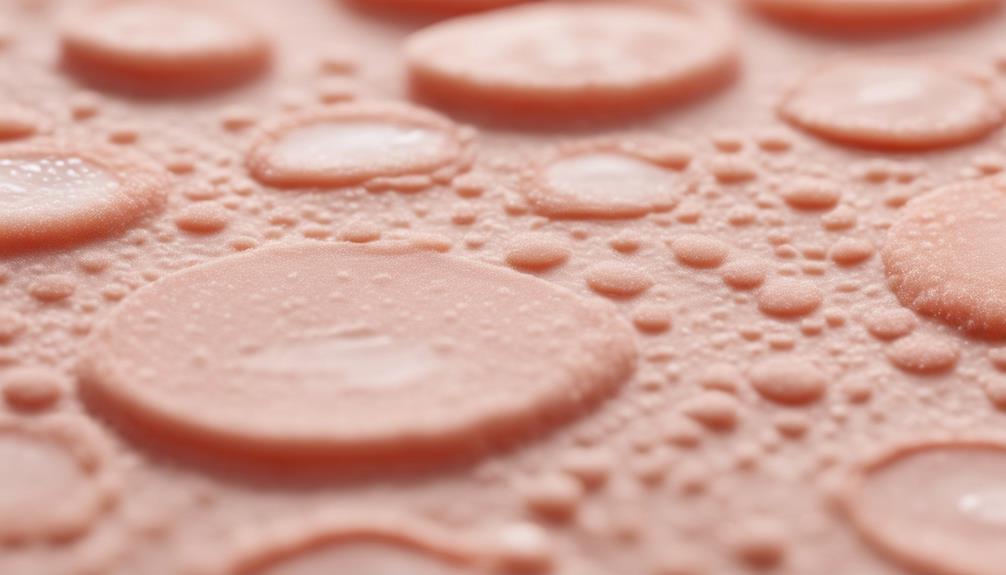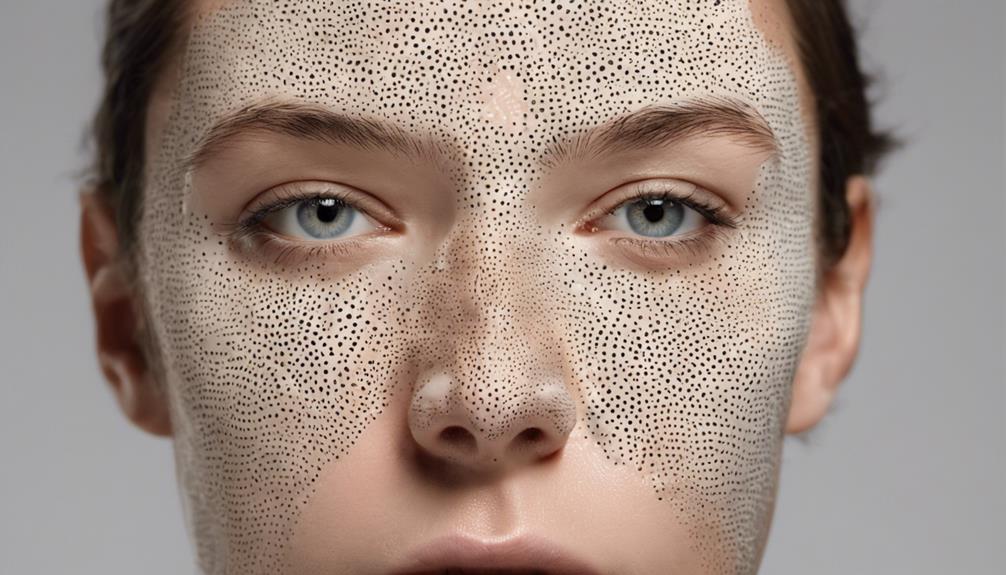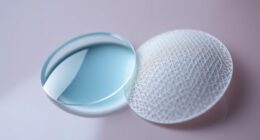Pimple patches work by using hydrocolloid material to absorb excess fluids and create a moist healing environment for your blemishes. They contain active ingredients like salicylic acid and tea tree oil that target acne-causing bacteria and reduce inflammation. By covering the pimple, they protect against external irritants, aiding in faster healing while minimizing scarring. If you’re curious about the different types and benefits of pimple patches available, there’s more to uncover.
Key Takeaways
- Pimple patches are adhesive stickers that treat individual blemishes by absorbing excess fluids and protecting against irritants.
- They utilize hydrocolloid material to create a moist healing environment, which helps reduce inflammation and promotes faster recovery.
- Active ingredients like salicylic acid and tea tree oil target acne-causing bacteria and unclog pores for effective healing.
- Patches absorb pus and oil from pimples, visibly swelling to indicate their effectiveness while preventing scarring.
- They provide a barrier against external irritants, minimizing the risk of infection and allowing for localized treatment of acne.
What Are Pimple Patches?
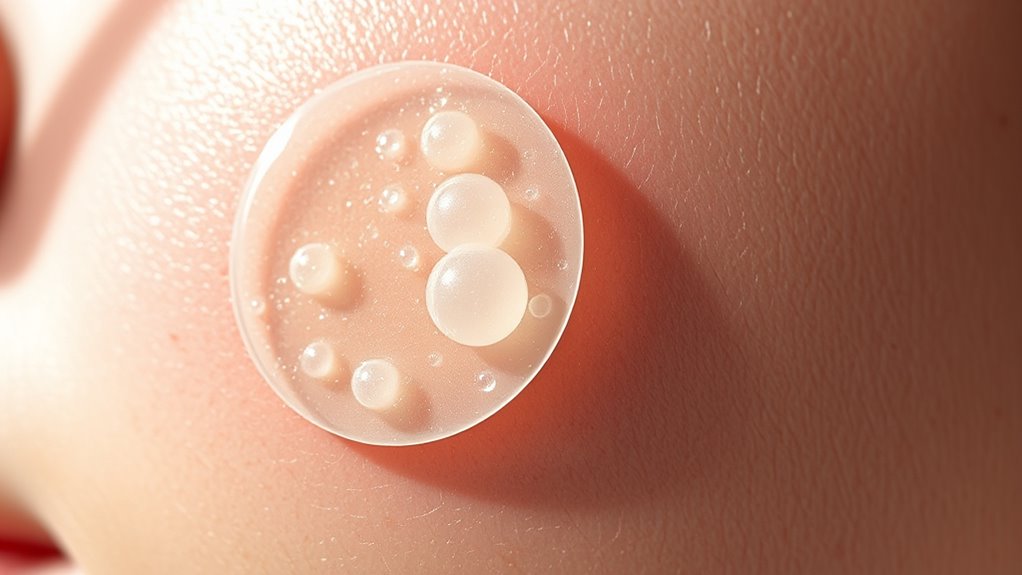
Pimple patches are innovative skincare solutions that help tackle blemishes effectively. These adhesive stickers are designed to treat individual pimples by absorbing excess fluids and protecting them from external irritants.
Their purpose is to promote faster healing and reduce scarring by maintaining a moist environment. You can apply them to various skin types, typically on surface-level pimples like whiteheads. However, they’re less effective for deeper acne forms, such as cystic acne. Acne types can influence which patches are most suitable for your specific skin concerns.
Pimple patches come in several types, including hydrocolloid, medicated, and microneedling options, each catering to different needs. They create a protective barrier, absorb impurities, and prevent you from picking at blemishes, making them a convenient addition to your skincare routine.
Key Ingredients in Pimple Patches
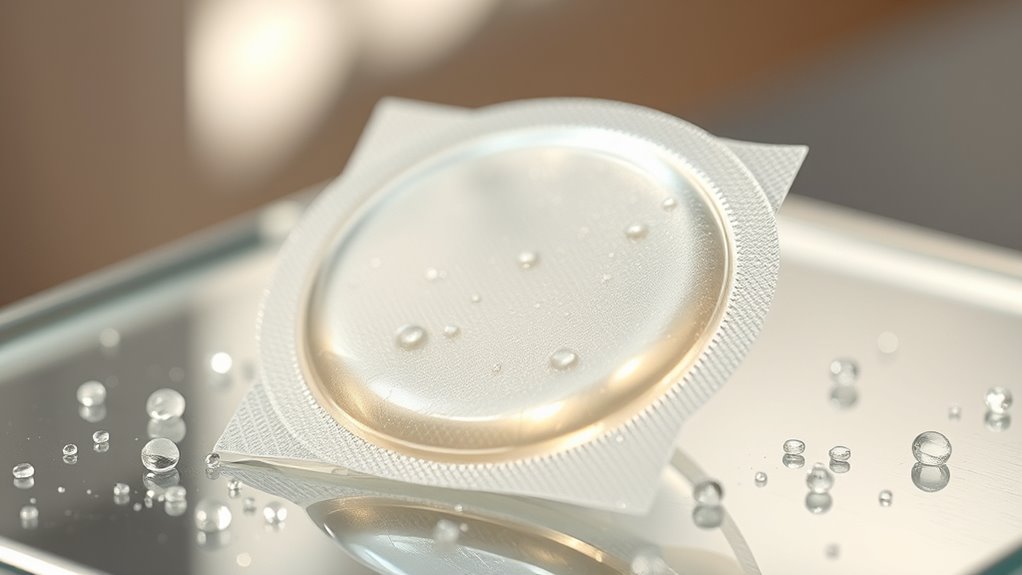
When it comes to effectively treating blemishes, understanding the key ingredients in pimple patches can enhance your skincare routine.
Salicylic acid is a staple, exfoliating the skin and unclogging pores to reduce inflammation. Tea tree oil brings antibacterial properties, attacking acne-causing bacteria directly.
For hydration, hyaluronic acid supports moisture retention, while niacinamide improves skin elasticity and reduces redness. Advanced patches often feature peptides to promote skin regeneration. Pimple patches are adhesive stickers placed directly on pimples, designed for targeted, convenient, and discreet treatment of breakouts.
Each ingredient plays a role: salicylic acid and tea tree oil target acne, while hyaluronic acid guarantees a moist healing environment.
Whether you have sensitive, oily, dry, or combination skin, there’s a patch with ingredients tailored for you, making these patches a versatile addition to your acne-fighting arsenal.
How Hydrocolloid Material Works

Hydrocolloid material plays an essential role in the effectiveness of acne patches, utilizing its moisture-absorbing properties to promote healing.
This unique material creates a moist environment, which helps absorb excess fluids like pus and oil from your pimples. Made from ingredients like gelatin and carboxymethyl cellulose, hydrocolloid patches have proven effective for mild to moderate acne, such as whiteheads and pustules. As the patch absorbs fluid, it swells and turns white, visually indicating its effectiveness. It not only aids in reducing inflammation and redness but also protects your skin from external bacteria, preventing infection and potential scarring. Additionally, the hydrocolloid material acts as a barrier against external irritants, enhancing the healing process and preventing further irritation.
The Role of Medicated Ingredients

Acne patches not only rely on hydrocolloid material but also incorporate medicated ingredients that enhance their effectiveness.
Salicylic acid penetrates deep into pores to clear out dirt and bacteria, while tea tree oil offers antibacterial properties, reducing pimple size and healing time.
Hyaluronic acid balances moisture, soothing irritated skin and preventing dryness. Medicated patches are designed specifically for inflamed acne, making them a targeted solution for those experiencing more severe breakouts.
Niacinamide improves skin texture and tone, stabilizing your skin’s barrier function.
Benzoyl peroxide acts as an antiseptic, effectively tackling bacteria but may irritate sensitive skin.
Together, these ingredients reduce redness and inflammation, prevent further irritation, and target specific types of acne, making patches a versatile option for treating mild breakouts while catering to various skin types.
Types of Pimple Patches Available
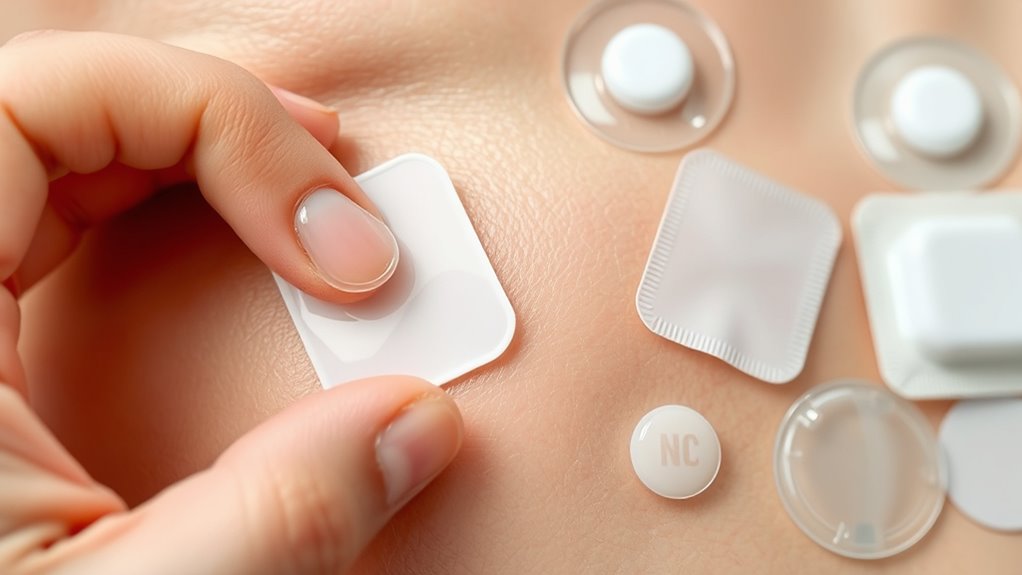
Pimple patches come in various types, each designed to tackle specific acne concerns effectively.
Hydrocolloid patches are non-medicated and work best for surface-level pimples with visible heads, absorbing excess fluid and pus.
If you’re dealing with inflammation and bacteria, salicylic acid patches can help reduce those issues.
For deeper or cystic acne, microneedling patches feature tiny needles that deliver active ingredients directly into the skin, although they mightn’t suit sensitive skin types. Pimple patches are typically made of hydrocolloid, a gel-forming material that absorbs water and draws out fluid from the pimple.
Each patch type targets different stages or types of acne, allowing you to choose the one that fits your needs.
Understanding these options can help you make informed choices for your skincare routine.
Benefits of Using Pimple Patches

One of the key advantages of using pimple patches is their ability to create a protective barrier over blemishes. By covering the pimple, these patches help prevent you from picking at it, which reduces the risk of infection and scarring.
They block bacteria from entering, minimizing redness and inflammation while acting as a shield against external contaminants. The hydrocolloid material absorbs pus and excess fluids, promoting a moist environment that speeds up healing. This hydrocolloid film also helps to decrease inflammation, further aiding the healing process.
Plus, with various designs, you can choose patches that suit your style. They’re convenient and portable, making them easy to use anywhere.
Effectiveness of Pimple Patches
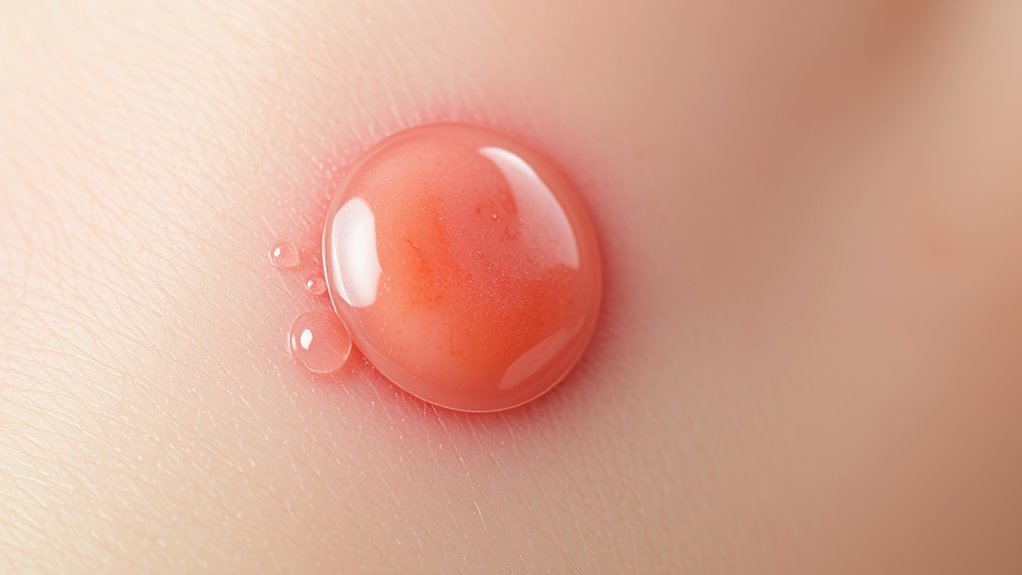
While pimple patches offer numerous benefits for managing breakouts, their effectiveness can vary depending on the type of acne you’re dealing with.
These patches work best on surface-level pimples, like pus-filled acne, by absorbing fluids and reducing inflammation. If you’re facing blackheads or whiteheads, pimple patches mightn’t be your best bet, as they don’t penetrate deeply enough. Cystic acne also isn’t suitable for patches since they can’t reach the underlying issues. However, if you catch a pimple early, patches can help halt its development. They create a protective barrier, promote healing, and discourage picking, which can worsen your acne. For ideal results, consider combining them with other treatments like benzoyl peroxide. Additionally, hydrocolloid patches create a moist environment that aids in the healing process.
Potential Limitations and Side Effects

Although pimple patches can be an effective solution for managing breakouts, they do come with potential limitations and side effects that you should be aware of.
For instance, avoid using them on open wounds, as this can trap bacteria and slow healing. They also fall short when it comes to treating deeper cystic acne, as pimple patches primarily address surface-level issues.
Some ingredients might cause irritation or allergic reactions, especially if you have sensitive skin. Overreliance on patches can give you a false sense of security, delaying necessary treatments for more severe issues.
Some ingredients may irritate sensitive skin, and relying too much on patches can postpone essential treatments for serious acne concerns.
You might also experience mild redness or dryness, particularly with medicated patches. Always perform a patch test and consult a dermatologist for severe acne to guarantee you’re using the right approach for your skin.
Frequently Asked Questions
How Long Should I Leave a Pimple Patch On?
You should leave a pimple patch on for about 6 to 8 hours for ideal results. This duration allows the patch to effectively absorb pus and reduce inflammation.
If you’re dealing with a stubborn pimple, you might consider wearing it overnight for 8 to 12 hours, which can help you wake up to a visibly reduced size and redness.
Just remember to remove it when it turns white, signaling it’s time to take it off.
Can Pimple Patches Be Reused?
Ever thought about reusing a pimple patch? You can’t!
Once you’ve used it, it’s soaked with oil and bacteria, making it a breeding ground for infection. These patches are designed for single use, so don’t risk your skin’s health.
Instead, grab a fresh one for each application. By doing so, you’ll guarantee you’re treating your pimples effectively without compromising your skin’s safety.
Trust me, your skin will thank you!
Are Pimple Patches Suitable for Sensitive Skin?
Yes, pimple patches can be suitable for sensitive skin.
They’re typically made from hydrocolloid material, which absorbs fluids gently and creates a protective barrier.
You’ll find that these patches help reduce inflammation while keeping the area clean and irritation-free.
Look for non-medicated options to avoid harsh ingredients, and check for soothing additives like hyaluronic acid.
Always perform a patch test to verify compatibility with your skin before using them.
Do Pimple Patches Work on All Types of Acne?
Pimple patches don’t work on all types of acne.
They’re most effective on surface-level breakouts like whiteheads and pustules, as they absorb fluids and reduce inflammation.
For deeper cystic acne, you might need different treatments, since patches aren’t as effective there.
When choosing a patch, consider your skin type and the stage of your acne.
Using patches can protect the area while you seek more thorough solutions for stubborn spots.
Can I Apply Makeup Over a Pimple Patch?
You can absolutely apply makeup over a pimple patch, and it can feel like magic for your skin!
Just make sure to choose the right type of patch, like translucent or specialized options.
Gently dab your foundation or concealer around the patch, avoiding heavy layers that draw attention.
This way, you’ll camouflage the blemish while letting the patch work its wonders, keeping irritation at bay and allowing you to shine confidently!
Conclusion
In the battle against breakouts, pimple patches stand as both a shield and a sword. They absorb excess fluid while delivering targeted treatment, making them a quick fix for pesky pimples. Yet, despite their effectiveness, they’re not a cure-all; deeper skin issues may require more than just a patch. Embracing their convenience can lead to clearer skin, but remember that every solution has its limits—balance is key to achieving your best complexion.



